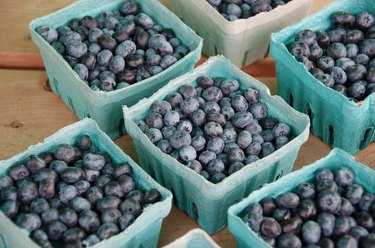
A balanced diet is one of the keys to good health. One way to ensure a balanced diet is to eat foods from all the food groups; another way is to balance your intake of acidic, or acid-forming, foods with alkaline foods. This helps your body maintain its pH balance, which is essential for proper physiological functioning and preventing disease. Knowing which foods are acid-forming, alkalizing and neutral can help you plan your meals.
Acid-Forming Foods
Video of the Day
Foods that create an acidic environment in the body include most processed foods, meat and fish, rice, cereal grains, sweeteners and sweetened foods, breads, pastas, cheese, caffeinated drinks, alcohol and condiments. Some nuts and seeds are acid-forming as well. Examples include beef, potato chips, salmon, chicken and pork. Artificial sweeteners, cane and beet sugars, barley syrup, processed honey, maple syrup and molasses are all acidic. Some fruits and vegetables are acid-forming, including most types of beans, dried-sulfured fruits, blueberries and cranberries. Acidic nuts include walnuts, pecans, cashews, pistachios, macadamias, filberts, Brazil nuts and peanuts. Sunflower and pumpkin seeds are also acid-forming. Mustard, ketchup, mayonnaise and vinegar are examples of acidifying condiments. Cola, coffee, sweetened teas, fruit juices beer and wine are acid-forming beverages.
Video of the Day
Alkalizing Foods
Eating plenty of alkalizing foods helps balance the effects of acidic foods in the body. Most fresh fruits and vegetables are alkalizing. This includes lettuces; all types of potatoes; cruciferous vegetables including broccoli, kale, Brussels sprouts and cauliflower; herbs, such as parsley and dill; and carrots, beets, eggplant and sprouts. Sprouted beans are also alkalizing. Alkalizing fruits include avocados, pears, peaches, cherries, apples, all types of melon, bananas, dates, papayas, figs and grapes. Some dairy products are alkaline, such as buttermilk, raw milk, plain yogurt and acidophilus milk. Amaranth and quinoa are alkalizing grains, and almonds, chestnuts and fresh coconut are alkalizing nuts. Other alkaline foods include honey, kelp, tea and egg yolks.
Neutral Foods
Neutral foods have neither an acidic nor alkaline effect on the body when consumed. Neutral foods include unsalted, fresh butter; fresh, raw cream; raw cow's milk and whey; and margarine and oils.
Creating a Healthy Balance
Just because a food is acid-forming doesn't mean you shouldn't eat it. You need some acid-forming foods in your diet because they are sources of important nutrients such as heart-healthy fatty acids from fish and B vitamins from grains. The key is to eschew unhealthy acid-forming foods like potato chips, refined grains, sweeteners and colas, and choose healthy sources like lean meats, whole grains and plain dairy. Make sure to eat plenty of alkalizing fruits and vegetables. If you follow the U.S. Department of Agriculture's recommendation to fill half your plate with fruits and vegetables at each meal, you're on your way to better health.
- Journal of Environmental and Public Health: The Alkaline Diet: Is There Evidence That an Alkaline pH Diet Benefits Health?
- Dr. David Williams: Acid-Forming and Alkalinizing Foods
- Edgar Cayce's A.R.E.: Acid-Forming & Alkaline-Forming Foods
- National Cancer Institute: Cruciferous Vegetables and Cancer Prevention
- Rense.com: A List of Acid / Alkaline Forming Foods
- American Heart Association: Fish and Omega-3 Fatty Acids
- Whole Grains Council: Whole Grains 101
- TeensHealth: MyPlate Food Guide